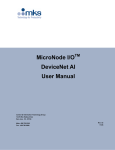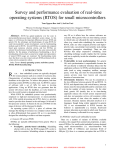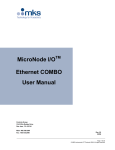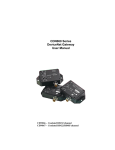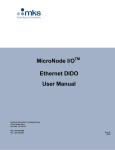Download MicroNode I/O DeviceNet AI User Manual
Transcript
TM MicroNode I/O DeviceNet AI User Manual Control & Information Technology Group 70 Rio Robles Drive San Jose, CA 95134 Main: 408.750.0300 Fax: 408.750.2990 Rev. 02 11/05 Page 1 of 27 © MKS Instruments CIT Products 2005, All rights reserved MicroNode I/OTM DeviceNet AI User Manual Copyright This manual and the software described in it are copyrighted with all rights reserved. Under the copyright laws, this manual and software may not be copied, in whole or part, without the prior written consent of MKS Instruments. The same proprietary and copyright notices must be affixed to any permitted copies as were affixed to the original. This exception does not allow copies to be made for others whether or not sold, but all of the materials purchased may be sold, given, or loaned to another person. Under the law, copying includes translating into another language or format. © MKS Instruments - CIT Products Group, 2005 70 Rio Robles Drive San Jose, CA 95134 Preface About this manual This manual is designed to serve as a guideline for the installation, setup, operation and basic maintenance of the MicroNode device. The information contained within this manual, including product specifications, is subject to change without notice. Please observe all safety precautions and use appropriate procedures when handling the MicroNode product and its related software. Page 2 of 27 © MKS Instruments CIT Products 2005, All rights reserved Table of Contents 1 GENERAL INFORMATION ..................................................................................................5 1.1 2 CONVENTIONS USED IN THIS USER MANUAL .................................................................................... 5 INSTALLATION AND SETUP ..............................................................................................6 2.1 SHIPPING BOX CONTENTS.............................................................................................................. 6 2.2 MICRONODE HARDWARE DESCRIPTION .......................................................................................... 6 2.3 INSTALLATION ................................................................................................................................ 6 2.4 WIRING ......................................................................................................................................... 7 2.5 ROTARY SWITCHES ....................................................................................................................... 7 2.6 CONFIGURATION ............................................................................................................................ 8 2.6.1 Power Supply Wiring............................................................................................................... 8 2.6.2 I/O Wiring ................................................................................................................................ 8 3 QUICK-START......................................................................................................................9 3.1 3.2 3.3 4 HARDWARE SETUP ........................................................................................................................ 9 CONFIGURING THE MICRONODE ..................................................................................................... 9 ENABLING THE I/O ......................................................................................................................... 9 THEORY OF OPERATION .................................................................................................10 4.1 DEVICENET INTERFACE ............................................................................................................... 10 4.1.1 Analog Inputs ........................................................................................................................ 10 5 MICRONODE CONFIGURATION.......................................................................................11 5.1 CONFIGURE DEVICENET INTERFACE ............................................................................................. 11 5.1.1 DeviceNet Baud Rate Switch................................................................................................ 11 5.1.2 MAC ID Switches .................................................................................................................. 11 5.2 POWER UP .................................................................................................................................. 11 5.2.1 DeviceNet Status LEDs ........................................................................................................ 12 5.3 REGISTER EDS FILE.................................................................................................................... 12 5.4 POLLED I/O CONFIGURATION ....................................................................................................... 12 6 DEVICENET OBJECT MODEL ..........................................................................................13 6.1 IDENTITY OBJECT CLASS CODE: 01 (0X01)................................................................................... 13 6.1.1 Revision – Attribute 4............................................................................................................ 14 6.1.2 Status – Attribute 5 ............................................................................................................... 14 6.1.3 Serial Number – Attribute 6 .................................................................................................. 15 6.2 ROUTER OBJECT CLASS CODE: 02 (0X02) ................................................................................... 15 6.3 DEVICENET OBJECT CLASS CODE: 03 (0X03) .............................................................................. 16 6.3.1 MACID – Attribute 1 .............................................................................................................. 16 6.3.2 Baud Rate – Attribute 2 ........................................................................................................ 16 6.3.3 Bus Off Interrupt – Attribute 3 ............................................................................................... 17 6.3.4 Bus Off Counter – Attribute 4................................................................................................ 17 6.3.5 Allocation Information – Attribute 5....................................................................................... 17 6.4 ASSEMBLY OBJECT CLASS CODE: 04 (0X04) ................................................................................ 17 6.4.1 Default Assembly Object Instance 1 and 2 Structure ........................................................... 18 CONNECTION OBJECT CLASS CODE: 05 (0X05)...................................................................................... 20 6.4.2 State – Attribute 1 .......................................................................................................... 21 6.4.3 Connection ID's – Attributes 4 and 5 .................................................................................... 21 6.4.4 Production and Consumed Sizes – Attributes 7 and 8 ......................................................... 21 6.4.5 Watch Dog Timeout Activity – Attribute 12 ........................................................................... 22 6.5 ANALOG INPUT POINT OBJECT CLASS CODE: 10 (0X0A) ............................................................... 22 6.5.1 Value – Attribute 3 ................................................................................................................ 22 6.5.2 Status – Attribute 4 ............................................................................................................... 23 6.6 S-DEVICE SUPERVISOR OBJECT CLASS CODE: 48 (0X30) ............................................................. 23 6.6.1 Device Status – Attribute 11 ................................................................................................. 24 Page 3 of 27 © MKS Instruments CIT Products 2005, All rights reserved MicroNode I/OTM DeviceNet AI User Manual 6.6.2 Exception Status – Attribute 12 ............................................................................................ 24 6.7 CONFIGURATION OBJECT CLASS CODE: 100 (0X64) ..................................................................... 24 6.7.1 Reset Service........................................................................................................................ 25 7 APPENDIX A - SPECIFICATIONS .....................................................................................26 8 WARRANTY .......................................................................................................................27 Page 4 of 27 © MKS Instruments CIT Products 2005, All rights reserved MicroNode I/OTM DeviceNet AI User Manual 1 General Information The MicroNode I/O™ product line provides high-density, compact, and economical I/O solutions for popular Fieldbus Networks. The MicroNode AI provides 16 analog inputs to a DeviceNet™ network. The MicroNode package provides flexible side or foot mounting and easy access to I/O through a standard 37-pin D-Sub connector. All physical and object model features are ODVA Semi SIG compliant. AS00107-01 AS00108-01 MicroNode I/O, DeviceNet, 16 AI, side MicroNode I/O, DeviceNet, 16 AI, front 1.1 Conventions used in this User Manual Warning The WARNING sign denotes a hazard to personnel. It calls attention to a procedure, practice, condition, or the like, which, if not correctly performed or adhered to, could result in injury to personnel. Caution The CAUTION sign higlights information that is important to the safe operation of the BlueBox, or to the integrity of your files. . Note THE NOTE SIGN DENOTES IMPORTANT INFORMATION. IT CALLS ATTENTION TO A PROCEDURE, PRACTICE, CONDITION, OR THE LIKE, WHICH IS ESSENTIAL TO HIGHLIGHT. On screen buttons or menu items appear in bold and cursive. Example: Click OK to save the settings. Keyboard keys appear in brackets. Example: [ENTER] and [CTRL] Pages with additional information about a specific topic are cross-referenced within the text. Example: (See page xxx) Page 5 of 27 © MKS Instruments CIT Products 2005, All rights reserved MicroNode I/OTM DeviceNet AI User Manual 2 Installation and Setup 2.1 Shipping Box Contents • MicroNode Product 2.2 MicroNode Hardware Description I/O 37 Pin DSUB See I/O Table Module Status LED (MOD) STATE DESCRIPTION OFF RED BLINK RED GREEN BLINK GREEN No power Configuration error Unrecoverable error Not defined Normal operation DeviceNet Status LED (NET) MicroNode I/O STATE DESCRIPTION OFF RED BLINK RED GREEN BLINK GREEN No power Configuration error Unrecoverable error Not allocated to a master Allocated to a master 2 DeviceNet Data Rate Rotary Switch DeviceNet Address Rotary Switches 3 1 5 4 DeviceNet Channel (male 5-pin micro connector) PIN SIGNAL 1 2 3 4 5 SHIELD V+ VCAN H CAN L 2.3 Installation Mount the MicroNode on a horizontal or vertical surface, in a suitable location or enclosure for your application. Provide sufficient clearance and airflow to maintain 0°C to 55°C ambient operating temperature range. Fasten the unit to the mounting surface using four screws (not provided) in the 4mm wide mounting holes. Page 6 of 27 © MKS Instruments CIT Products 2005, All rights reserved MicroNode I/OTM DeviceNet AI User Manual Height of 31mm, not including D-Sub 37 connector Note ALL DIMENSIONS ARE METRIC 2.4 Wiring The MicroNode requires two connections – one to the DeviceNet network (male 5-pin micro connector) and one to the 37-pin D-SUB. DeviceNet™ and I/O cables are available from a variety of industrial sources. See table below for orderable I/O mating connectors. Description Distributor Part Number 37-pin D-SUB Plug (solder cup) Mouser 523-17D-C37P 37-pin D-SUB metal hood Mouser 523-17-1727-2 Warning Follow all applicable electrical codes in your area when mounting and wiring any electrical device. 2.5 Rotary Switches Set the rotary switches to the desired settings. Use a small slotted screwdriver to rotate the switches. Align the indicator arrow to the desired setting, as shown below. switch position switch indicator switch screw slot Page 7 of 27 © MKS Instruments CIT Products 2005, All rights reserved MicroNode I/OTM DeviceNet AI User Manual Each rotary switch parameter has a PGM option. Setting a switch to PGM allows the parameter to be remotely set over DeviceNet. However, it must first be initialized. To initialize, set the switch to desired value and power up the unit. The new settings are saved in its memory. Power down and change switch to PGM mode. 2.6 Configuration Rotary switches and software parameters are used to configure the MicroNode’s DeviceNet Interface and I/O functions. The MicroNode is configured over DeviceNet. Use your DeviceNet configuration program and the MicroNode EDS file to set the software parameters over the DeviceNet channel. 2.6.1 Power Supply Wiring All network circuits and the analog circuits are powered from DeviceNet. Select your DeviceNet cables and power supply so that it can provide sufficient current for all networked devices at their peak operating power. 2.6.2 I/O Wiring The MicroNode has a female 37-pin D-Sub for I/O. The pinout is shown in the following table. I/O Pinout AI Model Connector Pin Signal Pin Signal 1 AI0 20 A GND 2 A GND 21 AI10 3 AI1 22 A GND 4 A GND 23 AI11 5 AI2 24 A GND 6 A GND 25 AI12 7 AI3 26 A GND 8 A GND 27 AI13 9 AI4 28 A GND 10 A GND 29 AI14 11 AI5 30 A GND 12 A GND 31 AI15 13 AI6 32 A GND 14 A GND 33 N.C. 15 AI7 34 Dnet V+ out 16 A GND 35 Dnet V+ out 17 AI8 36 Dnet V- out 18 A GND 37 Dnet V- out 19 AI9 Page 8 of 27 © MKS Instruments CIT Products 2005, All rights reserved MicroNode I/OTM DeviceNet AI User Manual 3 Quick-Start This chapter describes the setup for a simple system using a DeviceNet master and a MicroNode module. Before beginning, a basic understanding of DeviceNet is recommended. Experience using explicit and poll transactions from the software provided with your DeviceNet master is essential. For more information on generating explicit and poll messages consult the DeviceNet master’s user’s guide. 3.1 Hardware Setup Setup a connection between a DeviceNet master and the MicroNode. Required Hardware: • • • • DeviceNet cable DeviceNet master Power supply Voltage reference 3.2 Configuring the MicroNode The major steps for configuring the MicroNode include setting up the DeviceNet I/O Objects. Configure the MicroNode switches as follows: • MACID MSD to 0 • MACID LSD to 1 • DeviceNet Data rate to 500K Once all of the hardware is setup and powered, make sure that the master can allocate both poll and explicit connections to the MicroNode. Once allocated, both the NET and MOD LED will be solid green. Warning At this point, if the network and module LEDs on both the master and MicroNode are not solid green, do not proceed. Ensure the master baud rate matches the switch on the MicroNode, and that the MicroNode has a node address that is not used by another node on the network. 3.3 Enabling the I/O Configure a voltage reference (set between 0 – 10 V) and connect to an AI point (see connector pinout on section 2.6.2). Use Explicit Messaging to read the analog input and verify the input is reading your voltage reference through the network. Page 9 of 27 © MKS Instruments CIT Products 2005, All rights reserved MicroNode I/OTM DeviceNet AI User Manual 4 Theory of Operation This chapter describes how the MicroNode operates. Working knowledge of DeviceNet is required before continuing. The Open DeviceNet Vendors Association (www.odva.com) is a good source for general DeviceNet information. 4.1 DeviceNet Interface The DeviceNet Specification defines an Object Model that consists of Objects and Attributes. An Object is a predefined software process, and an Object Attribute is a data value used or created by that process. An Object can have multiple Instances, or the same process operating with different sets of Attributes or data values. For the purpose of this document, an Object Instance is an independent program or process, and its Attributes are configuration parameters and data values that are unique to that specific Object Instance. The MicroNode has eleven different Object Classes, or types. Five are standard objects defined by the DeviceNet Specification (Identity, Router, DeviceNet, Assembly, Connection). Other specific objects defined for the MicroNode include (Discrete Analog Input, Supervisory Object, User Defined Configuration Object). The MicroNode operates as a DeviceNet slave. It supports Explicit Messages and Polled I/O Messages of the predefined master/slave connection set. The Explicit Unconnected Message Manager (UCMM) is not supported. The MicroNode will be a Group 2 Only Slave device. It will support Polled I/O and Explicit Messaging. The DeviceNet interface complies with the DeviceNet Physical Layer specification. 4.1.1 Analog Inputs The Analog inputs are coupled directly to the processor and are implemented using 12 bit A/D converters. This device supports software settable ranges of 0V-10V, and –5V to +5V. All Analog circuitry is powered from an internal ± 15 Volt power source (1 Watt) derived from the 24 Volt DeviceNet power. The +15 and -15 VDC power is protected with a self-resetting poly fuse rated at 100 mA. Page 10 of 27 © MKS Instruments CIT Products 2005, All rights reserved MicroNode I/OTM DeviceNet AI User Manual 5 MicroNode Configuration This chapter describes how to configure and operate the MicroNode. The MicroNode is configured by reading and writing attribute values over the DeviceNet interface. There are a variety of DeviceNet configuration tools available. Simple configuration tools use GET_ATTRIBUTE and SET_ATTRIBUTE explicit message commands to read and write attribute values, addressing each attribute by its Object, Instance, and Attribute numbers. More sophisticated configuration tools use electronic datasheet files to simplify attribute configuration. 5.1 Configure DeviceNet Interface The DeviceNet Baud Rate and MAC ID Address are set using the rotary switches. Configure switches before connecting to the DeviceNet network. There is either a small triangular indicator or white indicator on the switch. Use a small screwdriver to align that indicator with the desired setting. 5.1.1 DeviceNet Baud Rate Switch Valid settings are 125K, 250K, 500K, or PGM. When PGM is selected, the MicroNode uses the baud rate saved in its retentive memory. To save a valid baud rate in memory, set the switch to the desired baud rate and power up the MicroNode for a few seconds. Power down and set the switch to PGM. You may also write to the DeviceNet Object Baud Rate attribute. POSITION 0 1 2 SETTING 125 Kbps 250 Kbps 500 Kbps 5.1.2 MAC ID Switches The two MAC ID switches represent decimal numbers from 00 to 99. The LSB switch selects the Ones digit and the MSB switch selects the Tens digit. Valid MAC IDs are 00 to 63. Setting a MAC ID address greater than 63 forces the unit to use the MAC ID saved in retentive memory. To save a valid MAC ID in memory, set the switches to the desired MAC ID and power up the MICRONODE for a few seconds. Power down and set the switches to value greater than 63. You may also write to the DeviceNet Object MAC ID attribute. MSB 0 1 2 3 4 5 6 LSB 0 to 9 0 to 9 0 to 9 0 to 9 0 to 9 0 to 9 0 to 3 Address 00 to 09 10 to 19 20 to 29 30 to 39 40 to 49 50 to 59 60 to 63 MSB 6 7 8 9 LSB 4 to 9 0 to 3 0 to 9 0 to 9 Address stored address stored address stored address stored address 5.2 Power Up Connect the DeviceNet network cable and I/O cable to power the MicroNode. Page 11 of 27 © MKS Instruments CIT Products 2005, All rights reserved MicroNode I/OTM DeviceNet AI User Manual 5.2.1 DeviceNet Status LEDs The MicroNode has two bi-color status LEDs (NET and MOD) that indicate operational status. During power-up, the LEDs cycle through a sequence of alternating red and green. After power-up, the NET LED should be flashing green (or solid green if allocated to a DeviceNet master) and the MOD LED should be solid green. If this does not occur, disconnect from DeviceNet and verify all the switch settings. State Off Flashing Red Solid Red Flashing Green Solid Green DeviceNet Status LED (NET) No power. Configuration error. Check DeviceNet switch settings. Unrecoverable error. Device not allocated to a DeviceNet master. Normal runtime, device allocated as a slave. State Off Flashing Red Solid Red Flashing Green Solid Green Module Status LED (MOD) No power. Configuration error. Check object attribute settings. Unrecoverable error. Not defined. Normal Operation. 5.3 Register EDS File If using a DeviceNet configuration tool that supports Electronic Data Sheet (EDS) files, the latest EDS file versions can be downloaded from www.mksinst.com. Select the EDS file that matches the part number and firmware version. Follow the configuration tool instructions to register EDS file. 5.4 Polled I/O Configuration A polled connection to the analog MicroNode will be determined by the Assembly Object. See Section 6 of the manual for the default polled connection list. Page 12 of 27 © MKS Instruments CIT Products 2005, All rights reserved MicroNode I/OTM DeviceNet AI User Manual 6 DeviceNet Object Model The analog MicroNode device operates as a slave on the DeviceNet network. The unit supports Explicit Messages and Polled I/O Messages of the predefined master/slave connection set. It does not support the Unconnected Message Manager (UCMM). DeviceNet Message Types (Slave Receive) As a group 2 slave device the Digital MicroNode supports the following received message types. CAN IDENTIFIER 10xxxxxx100 10xxxxxx101 10xxxxxx110 10xxxxxx111 GROUP 2 Message Type Master Explicit Request Message Master I/O Poll Command Message Unconnected Explicit Request Message Duplicate MACID Check Message xxxxxx = Node Address DeviceNet Object Classes The device supports the following DeviceNet object classes. CLASS CODE 01 (0x01) 02 (0x02) 03 (0x03) 04 (0x04) 05 (0x05) 010 (0x0A) 48 (0x30) 100 (0x64) OBJECT TYPE Identity Router DeviceNet Assembly Connection Analog Input Point S-Device Supervisor Configuration 6.1 Identity Object Class Code: 01 (0x01) The Identity Object is required on all devices and provides identification of and general information about the device. Table 1. Class Attributes Attribute 1 2 Access Get Get Name Revision Max Instance Type UINT UINT Value 1 1 Page 13 of 27 © MKS Instruments CIT Products 2005, All rights reserved MicroNode I/OTM DeviceNet AI User Manual Table 2. Instance 1 Attributes Attribute 1 2 3 4 Access Get Get Get Get 5 6 7 Get Get Get Name Vendor ID Device Type Product Code Revision Major Revision Minor Revision Status Serial Number Product Name Type UINT UINT UINT STRUCT of: USINT USINT WORD UDINT SHORT STRING Value 664 = “MKS – Tenta” 999 = Vendor Specific 390 See Below See Below See Below “DNI16AI” Table 3. Common Services Service Code 05 (0x05) 14 (0x0E) Class Instance Service Name No Yes Yes Yes Reset Get_Attribute_Single Table 4. Reset Service Reset Value 0 1 Description Reset device. Simulates recycling of the CPU power. Reset device to “out-of-box” configuration, then reset device. 6.1.1 Revision – Attribute 4 MKS/CIT maintains strict revision control. The major revision number will increment as functional enhancements are implemented. The minor revision will increment if minor changes are incorporated. 6.1.2 Status – Attribute 5 Bit (s): 0 Called: Owned 1 2 Configured 3 4, 5, 6, 7 8 Minor Recoverable Fault Definition TRUE indicates the device has an owner. Within the Master/Slave paradigm the setting of this bit means that the Predefined Master/Slave Connection Set has been allocated to a master. Reserved, set to 0. TRUE indicates the application of the device has been configured to do something different than the “out–of–box” default. This does not include configuration of the communications. Reserved, set to 0. Vendor-specific TRUE indicates the device detected a problem with itself, which is thought to be Page 14 of 27 © MKS Instruments CIT Products 2005, All rights reserved MicroNode I/OTM DeviceNet AI User Manual Bit (s): Called: 9 Minor Unrecoverable Fault 10 Major Recoverable Fault 11 Major Unrecoverable Fault 12, 13 14, 15 Definition recoverable. The problem does not cause the device to go into one of the faulted states. TRUE indicates the device detected a problem with itself, which is thought to be unrecoverable. The problem does not cause the device to go into one of the faulted states. TRUE indicates the device detected a problem with itself, which caused the device to go into the “Major Recoverable Fault” state. TRUE indicates the device detected a problem with itself, which caused the device to go into the “Major Unrecoverable Fault” state. Reserved, set to 0. Reserved, set to 0. 6.1.3 Serial Number – Attribute 6 The serial number is encoded in the product during the manufacturing cycle and is guaranteed to be unique across all product lines produced by MKS/CIT. 6.2 Router Object Class Code: 02 (0x02) The Message Router Object provides a messaging connection point through which a Client may address a service to any object class or instance residing in the physical device. Class or Instance Attributes are not supported. Page 15 of 27 © MKS Instruments CIT Products 2005, All rights reserved MicroNode I/OTM DeviceNet AI User Manual 6.3 DeviceNet ObjectClass Code: 03 (0x03) Table 5. Class Attributes Attribute 1 Access Get Name Revision Type UINT Value 2 Table 6. Instance 1 Attributes Attribute 1 2 3 4 5 Access Get/Set Get/Set Get/Set Get/Set Get Name MACID Baud Rate Bus Off Interrupt Bus Off Counter Allocation Information Choice Byte Master Node Addr. Type USINT USINT BOOL USINT STRUCT of BYTE USINT Value See Below See Below See Below See Below See Below Table 7. Common Services Service Code 14 (0x0E) 16 (0x10) 75 (0x4B) 76 (0x4C) Class Instance Service Name Yes No No No Yes Yes Yes Yes Get_Attribute_Single Set_Attribute_Single Allocate Master/Slave Release Master/Slave 6.3.1 MACID – Attribute 1 The MACID is set using two BCD rotary switches located on the front panel. Valid MACID addresses are 0 to 63 (0 to 3F Hex). Setting the switch address to a value greater than 63 will disable the switch and allow software setting of the MACID. If the switches are set to a value greater than 63, then the MAC ID attribute is settable. The software setting defaults to the last hardware setting. The switch is only read during power up. 6.3.2 Baud Rate – Attribute 2 Settable only if the Baud Rate switch is set to a value greater than 2. Value returned would be switch value if less than 3 or the last value set. Switch/Value 0 1 2 3 Speed 125 kbits 250 kbits 500 kbits Software settable Page 16 of 27 © MKS Instruments CIT Products 2005, All rights reserved MicroNode I/OTM DeviceNet AI User Manual 6.3.3 Bus Off Interrupt – Attribute 3 Bus Off Interrupt (BOI) determines the action if a Bus Off state is encountered. BOI Value 0 1 Action Hold chip on OFF state (default) Try to reset CAN controller. 6.3.4 Bus Off Counter – Attribute 4 Bus Off Counter will be forced to 0 whenever set, regardless of the data value provided. 6.3.5 Allocation Information – Attribute 5 Choice Byte Bit 7-2 1 0 Description Reserved. Always 0. If set, polled I/O connection to be allocated. If set, explicit message connection to be allocated. 6.4 Assembly Object Class Code: 04 (0x04) The Assembly Objects bind attributes of multiple objects to allow data to or from each object to be sent or received over a single connection. Table 8. Class Attributes Attribute 1 2 Access Get Get Name Revision Max Instance Type UINT UINT Value 2 2 Type STRUCT of BYTE Value Table 9. Instance 1 Attributes Attribute 3 Access Get Name Data Status Temp USINT Analog Inputs UINT[ ] See Configuration Object See Configuration Object See Analog Object Table 10. Instance 2 Attributes Attribute 3 Access Get Name Data Range Type STRUCT of BYTE [ ] Value See Analog Object Page 17 of 27 © MKS Instruments CIT Products 2005, All rights reserved MicroNode I/OTM DeviceNet AI User Manual Table 11. Common Services Service Code 14 (0x0E) 16 (0x10) Class Yes No Instance Yes Yes Service Name Get_Attribute_Single Set_Attribute_Single Data Type of AIO The data type of the analog inputs can either be INT or UINT. See the Analog Input Point object for the current setting. The data type of the Range is Bytes. See the Analog Input Point object for the current setting. Note Assembly instance 1 is used to generate the poll response packet and assembly instance 2 is used to consume the poll request packet. See section 6.7 for custom poll configuration. 6.4.1 Default Assembly Object Instance 1 and 2 Structure The table below shows the format of Assembly instance 1 and 2 with the “out-of-box” attributes values of the Configuration object. The poll produce size is 34 bytes and the consume size is 2 bytes by default. Instance 1 Byte 0 1 2 3 4 5 6 7 8 9 10 11 12 13 14 15 16 17 18 19 20 21 Bit 7 Bit 6 Bit 5 Bit 4 Bit 3 Bit 2 Exception Status – See S-Device Supervisor Object Temp – See Configuration Object AI 0 – LSB AI 0 – MSB AI 1 – LSB AI 1 – MSB AI 2 – LSB AI 2 – MSB AI 3 – LSB AI 3 – MSB AI 4 – LSB AI 4 – MSB AI 5 – LSB AI 5 – MSB AI 6 – LSB AI 6 – MSB AI 7 – LSB AI 7 – MSB AI 8 – LSB AI 8 – MSB AI 9 – LSB AI 9 – MSB Bit 1 Bit 0 Page 18 of 27 © MKS Instruments CIT Products 2005, All rights reserved MicroNode I/OTM DeviceNet AI User Manual Instance 2 Byte 22 23 24 25 26 27 28 29 30 31 32 33 0 1 Bit 7 Bit 6 Bit 5 AI 10 – LSB AI 10 – MSB AI 11 – LSB AI 11 – MSB AI 12 – LSB AI 12 – MSB AI 13 – LSB AI 13 – MSB AI 14 – LSB AI 14 – MSB AI 15 – LSB AI 15 – MSB Analog Input Range Analog Input Range Bit 4 Bit 3 Bit 2 Bit 1 Bit 0 Page 19 of 27 © MKS Instruments CIT Products 2005, All rights reserved MicroNode I/OTM DeviceNet AI User Manual Connection Object Class Code: 05 (0x05) The Connection Objects manage the characteristics of each communication connection. As a Group II Only Slave device the unit supports one explicit message connection and one poll I/O message connection. Table 12. Class Attributes Attribute 1 Access Get Name Revision Type UINT Value 1 Table 13. Instance 1 Attributes (Explicit Connection) Attribute 1 2 3 4 5 6 7 8 9 12 13 14 15 16 Access Get Get Get Get Get Get Get Get Get/Set Get/Set Get Get Get Get Name State Instance Type Transport Class Trigger Produced Connection ID Consumed Connection ID Initial Comm. Char. Production Size Consumed Size Expected Packet Rate Watchdog Timeout Action Prod. Path Length Production Path Cons. Path Length Consumed Path Type USINT USINT USINT UINT UINT USINT UINT UINT UINT USINT UINT Value See Below 0 = Explicit Message 0x83 See Below See Below 0x21 256 256 default 2500 msec See Below 0 (null) 0 (null) UINT Table 14. Instance 2 Attributes (POLL connection) Attribute 1 2 3 4 5 6 7 8 9 12 13 14 Access Get Get Get Get Get Get Get Get Get/Set Get/Set Get Get Name State Instance Type Transport Class Trigger Produced Connection ID Consumed Connection ID Initial Comm. Char. Production Size Consumed Size Expected Packet Rate Watchdog Timeout Action Prod. Path Length Production Path Log. Seg., Class Class Number Log.Seg., Instance Type USINT USINT USINT UINT UINT USINT UINT UINT UINT USINT UINT STRUCT of USINT USINT USINT Value See Below 1 = I/O Message 0x82 See Below See Below 0x01 See Below See Below 0 See Below 6 0x20 0x04 0x24 Page 20 of 27 © MKS Instruments CIT Products 2005, All rights reserved MicroNode I/OTM DeviceNet AI User Manual 15 16 Instance Number Log.Seg., Attribute Attribute Number Cons. Path Length Consume Path Log. Seg., Class Class Number Log.Seg., Instance Instance Number Log.Seg., Attribute Attribute Number Get Get USINT USINT USINT UINT STRUCT of USINT USINT USINT USINT USINT USINT 0x100 0x30 0x03 6 0x20 0x04 0x24 0x101 0x30 0x03 Table 15. Common Services Service Code 05 (0x05) 14 (0x0E) 16 (0x10) 6.4.2 Class Instance Service Name Yes Yes No Yes Yes Yes Reset Get_Attribute_Single Set_Attribute_Single State – Attribute 1 Connection State 0 1 3 4 Description Non-Existent Configuring Established Timed Out 6.4.3 Connection ID's – Attributes 4 and 5 Connection 1 Produced Connection ID: 10xxxxxx011 Connection 1 Consumed Connection ID: 10xxxxxx100 Connection 2 Produced Connection ID: 01111xxxxxx Connection 2 Consumed Connection ID: 10xxxxxx101 Note xxxxxx = Node Address. 6.4.4 Production and Consumed Sizes – Attributes 7 and 8 The Production and Consumed sizes will change based on the Assembly instance are structured based on the Configuration Object. The Table below will define the maximum Production and Consumed sizes will their respective Assembly. Page 21 of 27 © MKS Instruments CIT Products 2005, All rights reserved MicroNode I/OTM DeviceNet AI User Manual Assembly 1 2 Production Size 34 Consumed Size 2 6.4.5 Watch Dog Timeout Activity – Attribute 12 Watchdog Timeout Value 0 1 2 3 Description Timeout (I/O Messaging default) Auto Delete (Explicit Messaging default) Auto Reset Deferred Delete 6.5 Analog Input Point Object Class Code: 10 (0x0A) Table 16. Class Attributes Attribute 1 2 6 7 Access Get Get Get Get Name Revision Max Instance Max Class Attribute ID Max Instance Attribute ID Type UINT UINT UINT UINT Value 2 8 7 8 Table 17. Instance 1-8 Attributes Attribute 3 4 Access Get Get NV V V Name Value Status Type (See Value Data Type) BOOL 7 Get/Set NV Input Range USINT 8 Get/Set NV Value Data Type USINT Value See Below 0 = Okay 1 = Faulted 2 = 0V to 10V 6 = -5V to +5V 0 = INT 6 = UINT Table 18. Common Services Service Code 14 (0x0E) 16 (0x10) Class Instance Service Name Yes No Yes Yes Get_Attribute_Single Set_Attribute_Single 6.5.1 Value – Attribute 3 The following table is a list of values based the Input Range attribute, Value Data Type attribute, and the resolution of the ADC being 12-bits. Page 22 of 27 © MKS Instruments CIT Products 2005, All rights reserved MicroNode I/OTM DeviceNet AI User Manual Data Type Range -10V -5V 0V 5V 10V INT 0V to 10V 0x0000 0x0000 0x0000 0x0800 0x0FFF UINT 0V to 10V 0x0000 0x0000 0x0000 0x0800 0x0FFF INT -5V to +5V 0xF800 0xF800 0x0000 0x07FF 0x07FF UINT -5V to +5V 0x0000 0x0000 0x0800 0x0FFF 0x0FFF 6.5.2 Status – Attribute 4 If the ±15V input power falls below tolerance, the analog input point’s value will be indeterminist and the status will report as faulted. Also, if there is a bad read on the ADC, that channel will be faulted as well. 6.6 S-Device Supervisor Object Class Code: 48 (0x30) Table 19. Class Attributes Attribute 1 2 Access Get Get Name Revision Max Instance Type UINT UINT Value 1 1 Table 20. Instance 1 Attributes Attribute 3 4 Access Get Get NV NV NV 5 Get NV 6 Get NV 7 Get NV 8 Get NV 9 Get NV 11 12 15 16 Get Get Get/Set Get/Set V V NV NV Name Device Type SEMI Standard Revision Level Manufacturer’s Name Manufacturer’s Model Number Software Revision Level Hardware Revision Level Manufacturer’s Serial Number Device Status Exception Status Alarm Enable Warning Enable Type SHORT STRING SHORT STRING Value “ANALOG INPUT” “E54-0997” SHORT STRING “TENTA” SHORT STRING “DNI16AI” SHORT STRING 1 SHORT STRING 1 SHORT STRING See Below USINT BYTE BOOL BOOL 16 AIP See Below 0=Disable, 1=Enable 0=Disable, 1=Enable Table 21. Common Services Service Code 05 (0x05) Class Instance Service Name No Yes Reset Page 23 of 27 © MKS Instruments CIT Products 2005, All rights reserved MicroNode I/OTM DeviceNet AI User Manual Service Code 06 (0x06) 07 (0x07) 14 (0x0E) 16 (0x10) Class Instance Service Name No No Yes No Yes Yes Yes Yes Start Stop Get_Attribute_Single Set_Attribute_Single Table 22. Object-Specific Services Service Code 75 (0x4B) 76 (0x4C) nor revision. Class Instance Service Name No No Yes Yes Abort Recover 6.6.1 Device Status – Attribute 11 Value 1 2 3 4 5 6 Description Self Testing Idle Self-Test Exception Executing Abort Critical Fault 6.6.2 Exception Status – Attribute 12 Bit 0 1 2 3 4 5 6 7 Function ALARM/ device-common ALARM/ device-specific ALARM/ manufacturer-specific Reserved – set to 0 WARNING/ device-common WARNING/ device-specific WARNING/ manufacturer-specific 1 == Expanded Method 6.7 Configuration Object Class Code: 100 (0x64) Table 23. Class Attributes Attribute 1 2 Access Get Get Name Revision Max Instance Type UINT UINT Value 1 1 Page 24 of 27 © MKS Instruments CIT Products 2005, All rights reserved MicroNode I/OTM DeviceNet AI User Manual Table 24. Instance 1 Attributes Attr 1 2 3 4 5 6 Access Get Get Get Get/Set Get/Set Get NV NV NV NV NV Name Number of Inputs Unit Temperature PSV Warning Temp Limit Critical Temp Limit PSV Critical Limit Type USINT SINT UINT SINT Value 15 Degrees C 60 70 450 UINT Table 25. Common Services Service Code 05 (0x05) 14 (0x0E) 16 (0x10) Class Instance Service Name No Yes No Yes 2 Yes Yes Reset Get_Attribute_Single Set_Attribute_Single 6.7.1 Reset Service If a reset service is sent, then the attribute values will return to the “out-of-box” configuration. Page 25 of 27 © MKS Instruments CIT Products 2005, All rights reserved MicroNode I/OTM DeviceNet AI User Manual 7 Appendix A - Specifications Physical Specifications Criteria Dimensions I/O Connector DeviceNet™ Connector Weight Specifications 80mm (3.1496”) Height X 120mm (4.7244”) Width X 31mm (1.22”) Depth 37-pin female D-sub 5-pin male microfast 200 g (0.44 lb) Environmental Specifications Criteria Operating Temperature Storage Humidity Specifications 0 to +55°C -40 to +85 °C 5 to 95% non-condensing Functional Specifications Criteria BUS Interface Front Panel Indicators Rotary Switches Specifications DeviceNet™ Network Status, Module Status MAC ID and Baud Rate Power Specifications Criteria Input Isolation Specifications Powered from DeviceNet™ +24VDC@120 mA min DC/DC Isolation DeviceNet™ Specifications Criteria Messaging I/O Compliance Specifications Explicit messaging Polled I/O ODVA Semi SIG Compliant Input/Output Specifications Criteria Analog Input Specifications 16 points, single-ended 12-bit Software selectable range (0-10V), (–5 to +5V) Page 26 of 27 © MKS Instruments CIT Products 2005, All rights reserved MicroNode I/OTM DeviceNet AI User Manual 8 Warranty MKS Instruments, Inc. (MKS) warrants that for one year from the date of shipment the equipment described above (the “equipment”) manufactured by MKS shall be free from defects in materials and workmanship and will correctly perform all date-related operations, including without limitation accepting data entry, sequencing, sorting, comparing, and reporting, regardless of the date the operation is performed or the date involved in the operation, provided that, if the equipment exchanges data or is otherwise used with equipment, software, or other products of others, such products of others themselves correctly perform all date-related operations and store and transmit dates and date-related data in a format compatible with MKS equipment. THIS WARRANTY IS MKS’ SOLE WARRANTY CONCERNING DATE-RELATED OPERATIONS. For the period commencing with the date of shipment of this equipment and ending one year later, MKS will, at its option, either repair or replace any part which is defective in materials or workmanship or with respect to the date-related operations warranty without charge to the purchaser. The foregoing shall constitute the exclusive and sole remedy of the purchaser for any breach by MKS of this warranty. The purchaser, before returning any equipment covered by this warranty, which is asserted to be defective by the purchaser, shall make specific written arrangements with respect to the responsibility for shipping the equipment and handling any other incidental charges with the MKS sales representative or distributor from which the equipment was purchased or, in the case of a direct purchase from MKS, with the MKS-CIT home office in San Jose, CA This warranty does not apply to any equipment, which has not been installed and used in accordance with the specifications recommended by MKS for the proper and normal use of the equipment. MKS shall not be liable under any circumstances for indirect, special, consequential, or incidental damages in connection with, or arising out of, the sale, performance, or use of the equipment covered by this warranty. THIS WARRANTY IS IN LIEU OF ALL OTHER RELEVANT WARRANTIES, EXPRESSED OR IMPLIED, INCLUDING THE IMPLIED WARRANTY OF MERCHANTABILITY AND THE IMPLIED WARRANTY OF FITNESS FOR A PARTICULAR PURPOSE, AND ANY WARRANTY AGAINST INFRINGEMENT OF ANY PATENT. Page 27 of 27 © MKS Instruments CIT Products 2005, All rights reserved



























